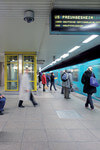What to do in an emergency
Here we explain our most important safety features and how to use them. We do, of course, hope that you’ll never need them. But in a serious situation, the lives and health of others could depend on you acting quickly and correctly – that’s why it’s important for you to familiarise yourself with these features.
Saving lives on underground platforms

There are at least three emergency signals on each underground platform. If any one of these signals is activated, all departing trains are halted, even those on the opposite platform.
Trains that are approaching the platform are warned via a signal in the tunnel. Even if a train should leave the platform, the driver is warned via a signal in the tunnel and is obliged to use the emergency brake. If, for example, someone should fall onto the track, the emergency stop handle must be pulled immediately. Please then go to the nearest emergency call point and inform the Safety and Service Centre without delay why you pulled the emergency stop handle.
Platform cameras

The B levels and platforms of all underground stations and the platforms from various stations and stops are monitored via video cameras connected to the Safety and Service Centre.
Emergency brake handles in the vehicles

Emergency brake handles are located next to the doors in all underground trains and trams. Underground trains: If you pull the emergency brake handle in an emergency, you can prevent a stationary train from leaving the station or bring a moving train to an immediate stop. Note: To prevent a moving underground train from stopping in the tunnel, an ‘emergency brake override’ cuts in a few seconds after the train leaves the station. If the emergency brake handle is then pulled, the train will continue to the next station for safety reasons and the driver will make an announcement to this effect. This is because we can provide assistance (such as evacuating passengers or putting out a fire) much more quickly and more easily when the train is in a station than when it is stopped between two stations.
The situation is different with trams. If a passenger pulls the emergency brake handle on a tram, the vehicle is prevented from departing or brought to an immediate stop by the emergency brake if it is moving.
Driver emergency call box

If there is no immediate danger to life, you can speak to the vehicle personnel via the driver emergency call box to describe the dangerous or emergency situation. All drivers will then take the necessary steps and summon assistance over the vehicle radio or stop the train. The driver emergency call boxes are located next to the doors. Please speak as calmly and clearly as possible. Only leave the emergency call box once you have answered all the driver’s questions.
Opening doors in an emergency
On underground trains, you can open the doors manually in an emergency. Unlock the doors using the lever located to the side that’s indicated for this purpose. You should then push them open with your hands, but only once the train has come to a complete stop.
Vehicle cameras

Some of VGF’s vehicles are under video surveillance. Currently 20 of our 103 trams and all "U4" and "U5" underground Trains are equipped with video cameras.
Emergency calls in stations

You’ll find emergency call boxes on all platforms in underground train stations. These will put you straight through to the Safety and Service Centre. Please state your name, your location and the reason for your emergency call. Please speak as calmly and clearly as possible. Only leave the emergency call box once you’ve answered all the questions asked by the member of staff in the control room.
Monitoring the train doors

Technical devices will inform the driver once all the doors are properly closed. Automatic doors on trains are safeguarded by light barriers and obstruction sensors. If there are any obstacles to these safety devices in the door area the door will reopen. Once the doors are completely closed, however, the safety devices will not allow them to reopen.
A technical device in the vehicles called a ‘start blocker’ will prevent the train from moving with open doors. Only when all the doors are closed can the train depart.
Emergency stop on escalators

All our escalators have emergency stop levers or buttons that can be used to bring the escalator to an immediate stop in dangerous situations, such as a person falling on the steps or clothes being caught. The escalator will stop with a sudden jolt if the emergency stop is activated, which may cause some passengers to fall. For this reason you should always hold on to the handrail when using the escalators.
After activating the emergency stop, you should immediately inform VGF’s Safety and Service Centre of the reason for doing so at the nearest emergency call point.
Emergency calls in the lifts

There are emergency call facilities in all lifts that will connect you directly to the VGF control centre. Our security team are specially trained in rescuing passengers from lifts and will be there as quickly as possible. In an emergency, you should state your name, your location and the reason for your call. Please speak as calmly and clearly as possible. Wait to answer any questions from the security staff. In any dangerous situation, you can also always call 110 or 112 as the police, the fire brigade and the VGF control centre are in direct telephone contact with one another.